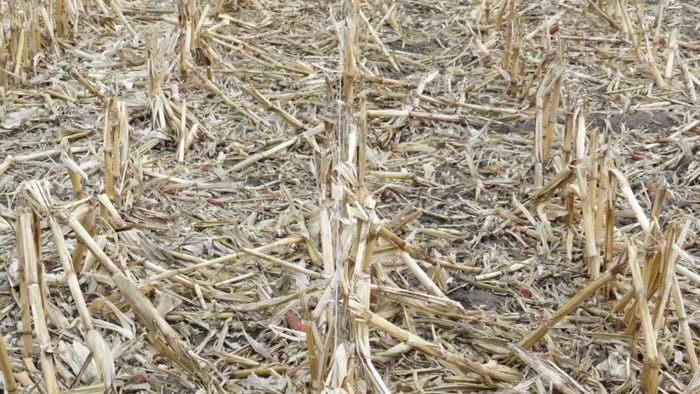
Grazing cattle on corn residue is not a new concept. However, as technology advances and there is less dropped corn, producers are wondering if cattle are reaching their nutritional requirements when grazing the residue.
As planters are rolling over cornstalk ground that was grazed over the fall and winter months, it is a good time to plan best practices on grazing crop residue, how to get the most out of the residue through proper stocking rates, and planning grazing fields for next fall.
“The No. 1 question that I get is, how long can a cow graze corn residue?” said Mary Drewnoski, Nebraska Extension beef systems specialist.
At the 2024 Three-State Beef Conference, Drewnoski walked producers through the updated recommendations for grazing corn residue, while giving practical solutions to calculating stocking rates.
Indicators for stocking rates
With higher yields because of advanced technology, digestibility when grazing starts to decrease. Updated recommendations suggest grazing one cow for 27 days for every 100 bushels of corn. For example, if you have 150 cows on 160 acres, and corn yielded 250 bushels per acre, you would be able to graze those cattle for 71 days.
To get to 71 days, you would take the 250-bushel yield divided by the recommended grazing of 100 bushels to get 2.5. From there you would take the 2.5 multiplied by the 27 days to get 67 days per acre. Multiply 67 days by the 160 acres to get 10,720 days, and then divide that by 150 cows to get the 71 days of grazing. (See table)

While that might be the recommended stocking rate, the best tool for farmers and ranchers is their eyes. When going into the field, producers should be on the lookout for how much husk is on the ground. The corn residue on the ground might show that there is plenty of cover. However, Drewnoski said unless there is still husk on the ground, it is time to supplement cattle or pull them off the field.
Cattle select husk and leaf when grazing corn residue. While the corn husks might be low in protein, they are high in energy. The longer cattle are out in the field, the lower their intake will be because they spend more time looking for leaves and husks. With less husk in the field, diet quality will decrease. Thus, the longer the cattle are out in a field, the less energy they consume.
“The best thing you can do is monitor the field, and when husk is hard to find, it's time to either move or start to supplement because she doesn't have access to the higher quality of feedstuffs. Otherwise, intake is going to be lower,” Drewnoski said.
But there are also weather conditions that can alter the quality of residue in the field. With high wind speeds, it can cause husks and leaves to drift away from the field, causing residue quality to decrease.
Another component producers should pay attention to is trampling loss. Higher-yielding fields are going to have a larger loss because of wind and trampling. Accounting for wind and trampling in stocking rates is crucial.
Supplementing cattle
Heifers have greater energy and protein requirements and require supplementation.
Based on Drewnoski’s research at the University of Nebraska, studies show it is best to supplement developing heifers with dried distillers grains to meet their protein requirements. DDG are high in protein, and if fed 2 pounds a day, cattle can have a daily rate of gain of 1 pound.
“You can vary the amount of distillers to achieve that rate of gain,” Drewnoski said. “So, depending on the rate of gain I'm looking for, I just can increase the amount of distiller supplementation.”

SPOT THE DIFFERENCE: On the right side of the photo, with an electric fence line separating, there are fewer husks available because cattle have been grazing that residue. On the left side is what it should look like when producers go to put cattle out on stalks. The number of husks available is a good indicator of grazing quality for cattle. The differences are subtle, but producers should be able to evaluate the situation on the ground. (Mary Drewnoski, UNL)
When thinking about supplementing bred heifers that are grazing corn residue, it is important to take into consideration where they are growing and gestating. During mid-gestation, the heifer will need 2 to 3 pounds of DDG to meet protein and energy requirements. Toward late gestation, supplement 3 to 5 pounds of DDG.
Additional research from Drewnoski’s team shows that when supplementing heifers, it is cost-effective to feed in bunks. There is 40% more utilization of the supplement when fed in bunks because there is less that is lost on the ground.
However, if grazing dry cows and practicing proper utilization, no supplementation should be needed. With a high-quality corn residue for the cows to graze, there is enough protein and energy to meet the requirements of a dry cow. If farmers and ranchers want to keep cattle out on the residue past prime forage quality, supplementation is crucial to reach the cow’s nutritional requirements.
For additional information about grazing cattle on corn residue, email Drewnoski at [email protected].
About the Author(s)
You May Also Like






